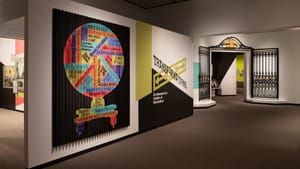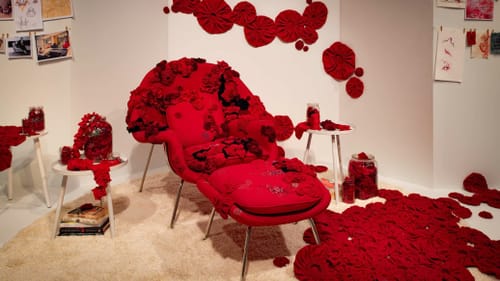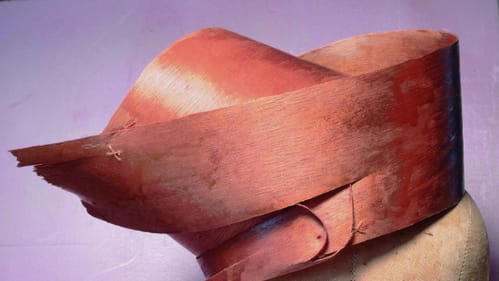Stay in the Loop
BSR publishes on a weekly schedule, with an email newsletter every Wednesday and Thursday morning. There’s no paywall, and subscribing is always free.
Generations of creativity
Winterthur presents Transformations: Contemporary Artists at Winterthur

For its latest major exhibition—and it is indeed major—Winterthur gathered a bevy of accomplished American artists who foraged for inspiration through its monumental collections. The works they created are now on view in the exceptional, riveting, and beautiful Transformations: Contemporary Artists at Winterthur.
On the gallery’s ground level, viewers are greeted by Stream Float, a magnificent quilt by Damon Smith (Maryland) inspired by Winterthur’s remarkable Gees Bend quilt. But this is only a prelude to what awaits in the museum’s second-floor gallery. Throughout this highly imaginative, beautifully installed, and immensely rich exhibition, curator Catharine Dann Roeber has creatively linked often-remarkable contemporary creations to the Winterthur pieces that inspired them.
Compelling invitations
The exhibition begins at Opening the Gates, beautiful wrought iron forged by Peter Mouet and Joseph Gaskell (early 1800s) for Stephen Girard’s Philadelphia Bank. These gates are of course an invitation to view the artworks, but on the deeper level (at which this exhibition excels), they are also an invitation into the imaginations of the 30 artists whose collaged pictures grace a facing wall.
In a feat of meta-historicity-artistry, this exhibition’s logo graphic itself was transformed into an oversized three-dimensional work. Its painted wooden slats mimic Cyclops/Memento Mori, a shape-shifting piece by innovative printmaker Rebecca Gilbert (Philadelphia) that was itself inspired by Nathaniel Currier’s 1862 “movable book” style print displayed next to Gilbert’s piece. The exhibition is redolent with such multiple (and often witty) layers.

One is The Opposite of Hate Is Mending by Kate Sekules (New York, New York). Sekules works in the “visible mending” makers movement, and here is her “statemend” sweater, coupled with Winterthur’s mended cotton jacket (c. 1800-1900). Both sit happily beneath two clotheslines holding 23 pairs of socks collected by a woman who kept her husband’s socks over a period of 49 years. Sekules was so riveted by this quirky collection that she created an international network of Sock Sisters (25 women in eight countries) who mended these well-worn items in creative ways.
Traditional works meet “take care”
Filled with contrasts, Transformations swings sometimes to more traditional works. Margaret O'Neil (Philadelphia) reconstructed an elegant period gown that speaks in several ways to the Boston settee (1760-75) next to it, both made with the same historic tapestry fabric. And Winterthur’s huge collection of chairs inspired four furniture makers. Their creations range from the exuberantly painted Throne of Laurel by Ellie Richards (North Carolina)—twisted branches collected in the woods near her home—to a more sedate black settee built by Aspen Golann and Greg Pennington (Tennessee), which Golann elegantly gold-painted with a contemporary twist.
At the exhibition’s entrance is thoughtful “Take Care” wall text, noting that while some of these works are lighthearted, others respond to injustice or trauma. Dealing overtly with social injustice is an affecting work by Jennifer Steverson (Austin, Texas). Mojo for Climate Change consists of 75 small bags and pockets inspired by antique seed bags (also on view). Hanging on two lines, Steverson’s color-graduated bags are her “offering to the ancestors who were forced to labor in ... racist and colonial economies.” She also made an untitled, strongly graphic quilt (it, too, inspired by Gees Bend style) from sustainably grown and processed materials.
An alcove for sound
In an alcove with welcome seating is the work of composers Alexandra Cade (Merion, Pennsylvania) and Tommy Dougherty (San Diego, California), who met in college and have collaborated ever since. The duo wrote Winterthur Suite, short fugues of aural and haptic reactions to six items that caught their imagination: a sampler, Shaker furniture, a Winterthur clock, Jenny Lind ephemera, and Winterthur’s Japanese maples and ambient nature.
Accompanying an arresting 15-minute film, the composers imaginatively plumbed the sonic qualities they heard in these objects, with music imaginatively connected to visuals. But here is the exhibition’s only shortfall: noisy air handlers that mask some of the musical intricacies.
Boxes, hats, and jars
There’s a lively response to Winterthur’s hat boxes and bandboxes, used primarily by women in the 1700s and 1800s to store and transport hats, clothing, and personal items. Artist Andrew Raftery, professor of printmaking at Rhode Island School of Design, invited other artists to create modern versions, displayed here beside their historic inspirations. The beautifully constructed boxes were made by Benjamin Bartgis (Annapolis, Maryland) and they are enhanced by three of Judith Solodkin’s (New York, New York) whimsical hats, including one of wood veneer.

One of the exhibition’s most powerful works is ‘oi-ster, a three-foot-high water jar alongside 98 identical dun-colored jars by potters Omar Tate (Philadelphia) and Gregg Moore (Glenside, Pennsylvania). The small jars are incised with quotes from residents near Tate’s Philadelphia restaurant and were inspired by the large Winterthur salt-glazed stoneware jar (Thomas H. Commersaw, 1797) on view.
You are a maker, too
A charming interactive section encourages visitors to “take and break and create. You are a maker.” It includes four reproductions to color (not for kids only), magnetic objects to place on a collaged wall, and a dollhouse. And at the exhibition’s end is something unusual, a full wall of credits calling out all who made this exhibition—designers, registrars, installation and lighting personnel, conservators—a clear-eyed view of how many people are responsible for the exhibition’s beauty and success.
Transformations is the direct result of Winterthur’s Maker-Creator Research Fellowships, begun in 2017, and many of these artists were project Fellows. But “transformations” is somewhat of a misnomer, for this exhibition is less about change than about continuity, in artistic content and in the insistency and power of the creative drive across generations. Roeber and her artists have taken what could have been a pleasing, superficial exploration and instead given us a deeply felt, highly committed, and transfixing look at how (as Shakespeare said), the past is prologue and with us in the present.
What, When, Where
Transformations: Contemporary Artists at Winterthur. $8-$25, free for kids under two. Through January 5, 2025, at Winterthur Museum, Garden & Library, 5105 Kennett Pike, Winterthur. (800) 448-3883 or winterthur.org.
Accessibility
Winterthur has accessible parking. Museum, shuttle buses, garden trams, and most walking paths are wheelchair and stroller accessible; wheelchairs and strollers are available at no cost.
With advance notice, assistive listening systems and sign-language interpreters are available. Guide and service animals are welcome.
Daily exhibition guided gallery walks are free with admission, no reservations required, and begin in the Galleries Reception Area at 2pm.
Sign up for our newsletter
All of the week's new articles, all in one place. Sign up for the free weekly BSR newsletters, and don't miss a conversation.

 Gail Obenreder
Gail Obenreder